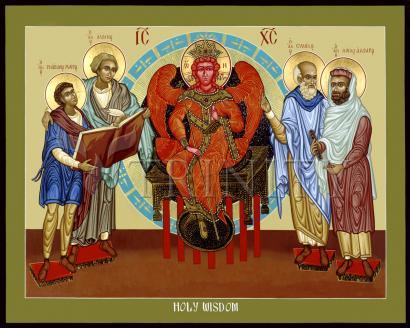Collection: Holy Wisdom

-
Sale
Wood Plaque Premium
Regular price From $99.95 USDRegular priceUnit price per$111.06 USDSale price From $99.95 USDSale -
Sale
Wood Plaque
Regular price From $34.95 USDRegular priceUnit price per$38.83 USDSale price From $34.95 USDSale -
Sale
Wall Frame Espresso
Regular price From $109.95 USDRegular priceUnit price per$122.17 USDSale price From $109.95 USDSale -
Sale
Wall Frame Gold
Regular price From $109.95 USDRegular priceUnit price per$122.17 USDSale price From $109.95 USDSale -
Sale
Wall Frame Black
Regular price From $109.95 USDRegular priceUnit price per$122.17 USDSale price From $109.95 USDSale -
Sale
Canvas Print
Regular price From $84.95 USDRegular priceUnit price per$94.39 USDSale price From $84.95 USDSale -
Sale
Metal Print
Regular price From $94.95 USDRegular priceUnit price per$105.50 USDSale price From $94.95 USDSale -
Sale
Acrylic Print
Regular price From $94.95 USDRegular priceUnit price per$105.50 USDSale price From $94.95 USDSale -
Sale
Giclée Print
Regular price From $19.95 USDRegular priceUnit price per$22.17 USDSale price From $19.95 USDSale -
Custom Text Note Card
Regular price From $300.00 USDRegular priceUnit price per$333.33 USDSale price From $300.00 USDSale
ARTIST: Lewis Williams, OFS
ARTWORK NARRATIVE:
In Proverbs, the virtues of Holy Wisdom (in Greek, Hagia Sophia, a grammatically feminine word) are extolled. In Proverbs 9: 27-31, Holy Wisdom was noted to have been present when God established the heavens and earth; at his side as craftsman, playing on the surface of the earth. He found delight in men. All men; not those we would pick and choose. Who is this Holy Wisdom who possesses all the fullness of the Godhead? In Corinthians 1:24, Paul clearly describes Sophia to be an attribute of Christ.
The men in this icon made Holy Wisdom their life’s pursuit, founding schools of Holy Wisdom and their efforts inspire us today. May we come to know Christ in wisdom’s quest. Our world cries out for wisdom’s fruit.
From the left, there is Bl. Rhabanus Maurus (b. 784 – d. 2/4/856). He was a poet, priest and Archbishop of Mainz. A student of Alcuin, Wisdom was his muse. A voluminous writer, he was well-known as the author of an early encyclopedia.
Bl. Alcuin (aka Albinus, b. 735 – d. 5/19/809). He was a deacon and famed scholar in Charlemagne’s court, where he headed a school of savants. His teacher, Archbishop Albert, was dedicated to the pursuit of Holy Wisdom.
In the center is Holy Wisdom as Christ in traditional iconographic depiction, winged, and enthroned on seven pillars of wisdom. The red\gold depict Christ’s heavenly radiance.
Next is St. Eulogius of Cordoba (b. 800 – d. 3/11/859). A priest, writer and calligrapher, he was an important link between Alcuin’s tradition and Spain’s Mozarabic Church. He ministered to martyrs under the Moors, wrote of their glories and was eventually martyred by beheading.
Bl. Paulo Alvaro (d. 7/27/852) married and made his career as a lawyer, writer and lay theologian. He carries a treasured gift from his teacher, Eulogius, of gold calligraphy on a purple parchment.
- Art Collection:
-
Christ Images,
-
Martyrs & Holy People
- Williams collection:
-
Jesus and Mary
The Byzantine East is filled with churches dedicated to Hagia Sophia -- Holy Wisdom. Holy Wisdom refers to Christ, a playful Christ at work in creation. “...when he laid down the foundations of the earth, I was at his side, a master craftsman, delighting him day after day, ever at play in his presence, at play everywhere in his world, delighting to be with the human race."
(Proverbs 8:29-31)
Wisdom is an androgynous Christ who embraces material creation. In Byzantine theology, all of creation has been called to be transfigured in Christ. Creation is actually groaning in anticipation of this, to use St. Paul's phrase. A world called to transfiguration is not a world for us to pillage and rape. Waste and pollution are moral issues at the heart of our faith.
The traditional Byzantine icon of Wisdom shows a winged androgynous figure flanked by St. John the Baptist and the Mother of God. The figure of Wisdom is bright red and wears imperial Byzantine robes. In this icon, Wisdom is a naked Third World child. The gold sphere represents eternity, and the brightly colored waves crashing wildly below represent the beginning of creation.
The concept of an androgynous Christ is important as we wrestle with issues of sexuality in our day. The Trinity is an essential part of our Christian faith, but its patriarchal matrix is not. As we begin to appreciate the feminine aspects of God, many of our other attitudes must also change. The image of Divine Sophia can assist us as we search.


















